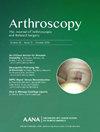Social Determinants of Health Disparities Increase 5-Year Revision Rates but Not Postoperative Complications After Primary Hip Arthroscopy
IF 4.4
1区 医学
Q1 ORTHOPEDICS
Arthroscopy-The Journal of Arthroscopic and Related Surgery
Pub Date : 2025-05-01
DOI:10.1016/j.arthro.2024.07.038
引用次数: 0
Abstract
Purpose
To investigate the impact of social determinants of health (SDOH) disparities on 30-day emergency department (ED) visits, 90-day postoperative complications, and 5-year secondary surgery rates after primary hip arthroscopy using a large national database.
Methods
A national administrative claims database was used to identify patients who underwent primary hip arthroscopy with femoroplasty, acetabuloplasty, and/or labral repair between 2015 and 2022. Queries were performed to identify patients who experienced any SDOH disparities, including economic, educational, environmental, or social disparities; those experiencing SDOH disparities within 1 year prior to primary hip arthroscopy were matched 1:1 by age, sex, Elixhauser Comorbidity Index score, diabetes, obesity, and tobacco use to patients not experiencing any lifetime SDOH disparities. The odds of 90-day complications and 30-day ED visits were compared using multivariable logistic regression. Rates of 5-year revision hip arthroscopy and of any secondary surgery (revision hip arthroscopy or total hip arthroplasty) were compared by Kaplan-Meier analysis.
Results
A total of 3,383 primary hip arthroscopy patients who experienced SDOH disparities were matched 1:1 to a control cohort of 3,383 patients who did not experience SDOH disparities (age of 41.0 years and 79.6% female sex in both cohorts). The odds of adverse events after arthroscopy were low and did not differ between the SDOH cohort (1.51%) and no-SDOH cohort (1.57%, P = .09). Additionally, there was no difference in the odds of 30-day ED visits between the SDOH cohort (5.65%) and no-SDOH cohort (4.79%, P = .10). The rate of 5-year revision hip arthroscopy was significantly greater among patients experiencing SDOH disparities (5.4% vs 4.1%, P = .02); however, there was no difference in the rate of any secondary surgery between cohorts (11.8% vs 10.4%, P = .10).
Conclusions
Patients experiencing SDOH disparities had similar odds of postoperative complications and ED visits after primary hip arthroscopy but greater rates of 5-year revision hip arthroscopy compared with a matched-control cohort of patients not experiencing SDOH disparities.
Level of Evidence
Level III, retrospective case-control study.
健康差异的社会决定因素会增加五年翻修率,但不会增加原发性髋关节镜术后并发症。
目的:利用一个大型全国性数据库,研究健康的社会决定因素(SDOH)差异对初级髋关节镜手术后30天急诊科(ED)就诊率、90天术后并发症和5年二次手术率的影响:方法: 使用全国行政索赔数据库来识别在 2015 年至 2022 年期间接受股骨成形术、髋臼成形术和/或唇修补术的初级髋关节镜手术患者。调查患者是否存在SDOH差异,包括经济、教育、环境或社会差异;根据年龄、性别、Elixhauser合并症指数评分、糖尿病、肥胖和吸烟情况,将在接受初级髋关节镜手术前1年内存在SDOH差异的患者与终生不存在SDOH差异的患者进行1:1配对。通过多变量逻辑回归比较了 90 天并发症和 30 天急诊就诊的几率。通过 Kaplan-Meier 分析比较了五年髋关节镜翻修率和二次手术(髋关节镜翻修或全髋关节置换术)率:共有 3,383 名经历过 SDOH 差异的初次髋关节镜手术患者与 3,383 名未经历过 SDOH 差异的对照组患者进行了 1:1 匹配(两组患者的年龄均为 41.0 岁,79.6% 为女性)。关节镜手术后发生不良事件的几率较低,且组群间无差异(SDOH:1.51%,与无 SDOH:1.57%;P=0.09)。此外,30天ED就诊率也没有差异(SDOH:5.65%;无SDOH:4.79%;P=0.10)。有SDOH差异的患者五年内进行髋关节镜翻修的比例明显更高(5.4% vs. 4.1%;P=0.02);但是,不同组群之间进行二次手术的比例没有差异(11.8% vs. 10.4%;P=0.10):结论:与不存在SDOH差异的匹配对照队列相比,存在SDOH差异的患者在初次髋关节镜手术后出现术后并发症和ED就诊的几率相似,但五年内进行髋关节镜翻修手术的比例更高:证据级别:3;回顾性病例对照研究。
本文章由计算机程序翻译,如有差异,请以英文原文为准。
求助全文
约1分钟内获得全文
求助全文
来源期刊
CiteScore
9.30
自引率
17.00%
发文量
555
审稿时长
58 days
期刊介绍:
Nowhere is minimally invasive surgery explained better than in Arthroscopy, the leading peer-reviewed journal in the field. Every issue enables you to put into perspective the usefulness of the various emerging arthroscopic techniques. The advantages and disadvantages of these methods -- along with their applications in various situations -- are discussed in relation to their efficiency, efficacy and cost benefit. As a special incentive, paid subscribers also receive access to the journal expanded website.

 求助内容:
求助内容: 应助结果提醒方式:
应助结果提醒方式:


